- A
- B
- C
- D
- E
- F
- G
- H
- J
- K
- L
- M
- N
- O
- P
- R
- S
- T
- V
- W
Royal Victoria Gallery (SCC Newsletter February 1995)
Royal Victoria Gallery
BUST-LENGTH WORK.
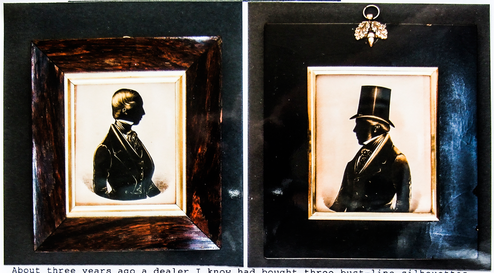 About three years ago a dealer I know had bought three bust-line silhouettes -two of which I have illustrated above. All were in identical rectangular rosewood frames.(the top-hatted gent has been temporarily reframed - as he was too large for his frame!) The third member of the 'party' (not illustrated) had an inscription on the back - a photostat copy of which I have photographed below. I think there is little doubt in view of this inscription that all three were by Fred Frith (also note the date 1843) The gold highlighting is of good quality and appears to be done in more than one shade of gold. It is possible that some yellow ochre has been used as described by Mrs. McKechnie (see p. 268) - but personally I find it very difficult to make the distinction. I would welcome your comments on this point. The brown wash at the base of the silhouettes appears to be rather casually painted - which is 'odd' in some ways - considering the care taken in other ways. Although on some of the full-length work of the Gallery the foregrounds are equally casually painted.
About three years ago a dealer I know had bought three bust-line silhouettes -two of which I have illustrated above. All were in identical rectangular rosewood frames.(the top-hatted gent has been temporarily reframed - as he was too large for his frame!) The third member of the 'party' (not illustrated) had an inscription on the back - a photostat copy of which I have photographed below. I think there is little doubt in view of this inscription that all three were by Fred Frith (also note the date 1843) The gold highlighting is of good quality and appears to be done in more than one shade of gold. It is possible that some yellow ochre has been used as described by Mrs. McKechnie (see p. 268) - but personally I find it very difficult to make the distinction. I would welcome your comments on this point. The brown wash at the base of the silhouettes appears to be rather casually painted - which is 'odd' in some ways - considering the care taken in other ways. Although on some of the full-length work of the Gallery the foregrounds are equally casually painted.
Mrs. McKechnie illustrates on p. 339 a bust-length silhouette of a young woman (the only bust-length example illustrated in her book.) She considers this to be most likely by H. A. Frith. She bases the view on the quality of the work and the date it was painted i.e.? 1843. Also, as she states on p. 268 she had not seen any bust-line examples by Fred Frith.
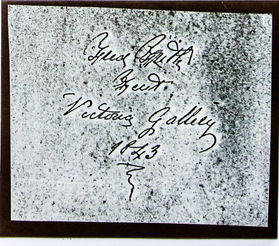
R. V. G. - Bust-length work cont.
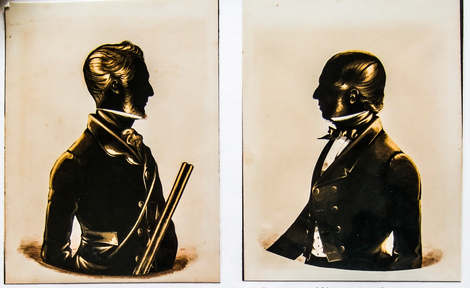 In the last few months 3 further examples of these silhouettes have come up at the Salerooms. (2 men & a woman, which are illustrated on this page - all are out of their frames so that detail of highlighting can be seen more clearly. Also, I have done two enlargements on the following page - to show detail of one man's hair & the bust-line of the young woman.) The two men just have their names (Caldwell) plus dates of birth & death - whereas the woman has an inscription, which appears to be in contempory writing and reads as follows:-
In the last few months 3 further examples of these silhouettes have come up at the Salerooms. (2 men & a woman, which are illustrated on this page - all are out of their frames so that detail of highlighting can be seen more clearly. Also, I have done two enlargements on the following page - to show detail of one man's hair & the bust-line of the young woman.) The two men just have their names (Caldwell) plus dates of birth & death - whereas the woman has an inscription, which appears to be in contempory writing and reads as follows:-
"likeness of Elizabeth Jane Campbell Davys cut-out with a pr. of scissors by Frith - Edinburgh, March 1848."
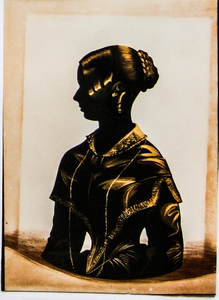 There is no record of the Friths going to Edinburgh at this time - although it is known that they went to Scotland and were there in 1830 at least. As no initial is given on this inscription I think from the date Mrs. McKechnie would assume the work was by H. A. Frith and this may well be the case.
There is no record of the Friths going to Edinburgh at this time - although it is known that they went to Scotland and were there in 1830 at least. As no initial is given on this inscription I think from the date Mrs. McKechnie would assume the work was by H. A. Frith and this may well be the case.
The gold highlighting on these 3 silhouettes seems to be 'identical' to that of the earlier 2. The woman is perhaps done in a slightly 'freer' style - but I am not sure if this is because it is done by another hand or because it is a woman!
Some of you may remember that I photographed a wonderful bust-line R. V. G. silhouette in my Newsletter of January, 1993. It was of a glamourous young woman in a fur wrap. It belonged to Martin Willcocks - a Club Member.
R. V. G. - Bust-line WORK cont.
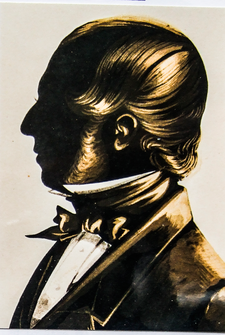 It was attributed to F. Frith but I did not register the significance of this at the time! The gold highlighting was superb and there appeared to be no yellow ochre used. Unfortunately Mrs. McKechnie was unable to trace the dates of death of either of the Frith brothers or their father - but she took the view that F. Frith Frith was possibly not active after 1842 - but H. A. Frith carried on working until about 1853 or so. A. Frith seems to have been better known for his 'coloured' work & caricature.
It was attributed to F. Frith but I did not register the significance of this at the time! The gold highlighting was superb and there appeared to be no yellow ochre used. Unfortunately Mrs. McKechnie was unable to trace the dates of death of either of the Frith brothers or their father - but she took the view that F. Frith Frith was possibly not active after 1842 - but H. A. Frith carried on working until about 1853 or so. A. Frith seems to have been better known for his 'coloured' work & caricature.
Fred Frith was the 'leading' silhouettist of the family it seems. John the father was a portrait & miniature painter and not likely to be 'significant' in this discussion I think. It seems that all 3 members of the family were in Limerick in 1841 & 1842 - so all were working actively in both those years. How they divided the work then or later I think would be difficult to speculate.
It is of note that there are many examples of the Gallery's work in the collection at Malahide Castle in Dublin. Some of these works have dates in the late 1840's and even up to 1851. Most of these are of very high quality as far as the gold-highlighting is concerned - although there are one or two with more cursory high-lighting. A more detailed study would have to be made of this collection - comparing date and style to come to any conclusions. Types of frames do not seem to have much to offer - it is also possible that some were not framed at the time. The two Caldwell men are in rosewood frames and the woman in a maple frame - all have gold insets. The frames of all 5 illustrated in this article are of varying size. A bust-length work was sold at Sotheby's in 1971 had a "carved leaf guiltwood frame."
I do not think one can come to any definate conclusions - other than bust-length work was painted both by Fred and H. A. Frith and that it is not possible to distinguish their work on stylistic grounds with any certainity. Date of execution may have something to offer but not knowing dates of death makes this difficult! It is also possible that both at times contributed to the same silhouette - we shall never know!
I would welcome comments on this article - especially from any of you with bust-line work of the Gallery that has a signature or inscription. I hope to have a more detailed article on the Malahide Castle Collection in the future. It is well worth a visit to any Club Member visiting Dublin.
Date:
1995-02
Images:






